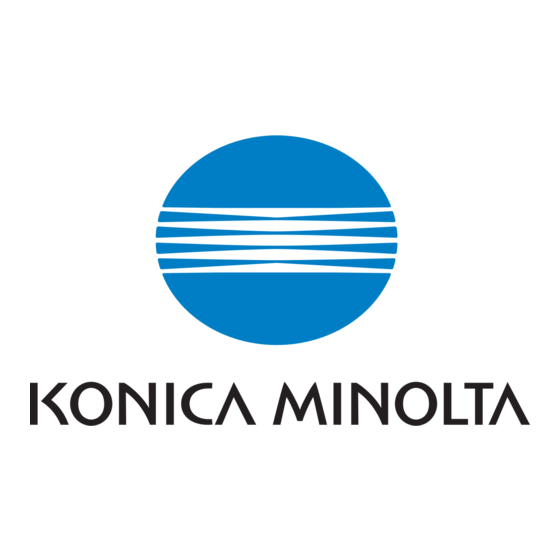
Advertisement
Quick Links
Advertisement

Subscribe to Our Youtube Channel
Summary of Contents for Konica Minolta 2560
- Page 1 Quick Configuration Guide Network Connectivity for Printers...
- Page 2 Introduction Easy installation 10 Mbps Ethernet Interface 10BaseT / 10Base2 Auto Detection Multiple Protocol support HTTP Server for Management with a Browser DHCP Support for Automatic IP Address Assignment SNMP Support Flash Upgrade Capability The DPO NIC enables printers to communicate over an Ethernet network with many different network operating systems, including NetWare, Macintosh, UNIX, and Windows.
-
Page 3: Table Of Contents
Contents NetWare 2.x & 3.x Configuration... 1 NetWare 4.x Directory Services Configuration ... 2 Macintosh Configuration... refer to Manual Windows 95 Peer to Peer Printing Configuration ... 6 DHCP Configuration ... 8 Windows NT Configuration ... 9 UNIX Configuration... 11... -
Page 4: Netware 2.X & 3.X Configuration
NetWare 2.x & 3.x Configuration Login as Supervisor and start PCONSOLE. Define the Print Queue. If a Print Queue already exists which will be assigned to the printer, skip to step 3. Select Print Queue Information from the Available Options menu Press INSERT, type a name for the new queue to be serviced by the NIC and press ENTER. -
Page 5: Netware 4.X Directory Services Configuration
Network Address, for example, 00:40:af:13:c9:f0. Please enter it as it appears on the status page. The status pages (a printer status page and a NIC network status page) may also be printed by pressing the Status key on the front panel of the printer. -
Page 6: Configuration Utilities
The current context is displayed in the upper left-hand corner of the screen. This is where the Print Server, Printer, and Queue will be located. If this is not the desired context for these objects, use the following procedure to change the current context. - Page 7 Print Server Name, as it must be duplicated exactly during setup with the Management Access Program. Print Server Name: Press ENTER at the New Printer and New Print Queue field to define desired names for these objects. Move to the Print Queue Volume field and press ENTER. Press INSERT and browse to the desired volume to use for this print queue.
- Page 8 Settings. After a few seconds the screen should report that the update was successful. Click the Back arrow icon twice to return to the NIC Configuration page. Optional: Click on Configure Status Page in the Printer column to define power-up status page settings, e.g. disabling the power-up status page.
-
Page 9: Windows 95 Peer To Peer Printing Configuration
Served based print services offer centralized printing management and spooling and do not require software (other than the printer driver) to be installed on each PC. Optional: Changing the Print Server Name The peer to peer printing software displays the NetWare Print Server Name to identify the NIC. - Page 10 Follow the instructions on the screen to complete installation of the peer to peer printing software. Select the Printer Port. If the printer driver has not already been installed, please install it before continuing with the following instructions. Click on the Windows 95 Start button and select Settings, then Printers.
-
Page 11: Dhcp Configuration
Dynamic Host Configuration Protocol (DHCP) The Dynamic Host Configuration Protocol (DHCP) provides a mechanism for delivering IP configuration parameters, including IP address, Subnet mask and default gateway, to devices (hosts) on an IP network. A DHCP server manages the pool of available IP addresses and grants device requests for an IP address. -
Page 12: Windows Nt Configuration
Windows NT Configuration There are several options for setting up printing in a Windows NT environment. If a NetWare server is present, NetWare print services may be used by following the NetWare Configuration instructions in this guide. Peer to peer print services may be used by following the Windows 95 instructions in this guide, but are only available for Windows NT 4.x, not for Windows NT 3.51. -
Page 13: Setting Up Lpr Printing
LPR1 and click OK to return to the Printer Properties dialog. If the printer is to be shared, click on the checkbox next to Share this printer on the network. Click on OK when finished. Windows NT 4.0 Click on the Windows 95 Start Button and select Settings, and the Printers. -
Page 14: Unix Configuration
For directions on using on of the other methods, please refer to the NIC User's Manual. Press the Status key on the front panel of the printer with the NIC, or if the printer is off, turn it on and wait for the power-up network status page to print. - Page 15 NIC's IP address is from 192 to 254, then use 255.255.255.0 as the Subnet mask. The Base Port Number displayed is one less than the printer's actual port number, this for the default of 9100, the Base Port Number is set to 9099. Host-based lpd requires a port number of 10001, therefore, if using host-based lpd, change the Base Port Number to 10000.



Need help?
Do you have a question about the 2560 and is the answer not in the manual?
Questions and answers